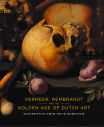
Vermeer, Rembrandt and the Golden Age of Dutch Art. Masterpieces from the Rijksmuseum, Amsterdam. By Ruud Priem and others. Vancouver Art Gallery and D & M Publishers Inc, 2009.
Art is often likened to a gadfly hovering over society’s dung heap. Conversely, it is also universally recognized as society’s most sublime expression. The latter is particularly true for the Golden Age of Dutch art, a five-decade period during the 17th Century that produced painters such as Rembrandt, Vermeer and Hal. It was the confluence of political events and the advent of mercantilism, banking and maritime exploration that led to the creation of unprecedented wealth in cities like Amsterdam, Haarlem, Leiden and Utrecht. Not to mention, of course, the infamous slave trade that flourished later on. This wealth, in turn, was invested in art, not in land, a scarce resource in tiny water-logged Holland. Moreover, unlike other European countries, power in the Netherlands was vested in the hands of merchants and craftsmen and not in the landed aristocracy, a not surprising phenomenon in a country that had become a republic.
The Netherlands had been part of the Spanish Empire until William I of Orange revolted against Philip II of Spain. This revolt led to the formation of the Republic of the Seven United Netherlands. In this republic, cities and provinces had a greater say in local as well as international policies. The Dutch East India Company was established in 1602 and the first commodity exchange opened in Amsterdam in 1611. Well-crafted household goods and art, mainly in the form of paintings, were objects of great value and were considered investments, not goods to be consumed. Artists were well paid although some of them, like Rembrandt, became victims of financial mismanagement.
In this new democratic (for the historical period in question) society, the artists organized themselves into professional guilds to protect the quality of their products and their own professional worth. These guilds also served as educational as well as social security institutions. Artists did not depend on the patronage of the nobility or the church. It was City Hall or other artists or members of the bourgeoisie who commissioned their work. Many artists painted their self-portraits in which they documented their own success as part of the composition of the painting.
The Rijksmuseum has lent many of these masterpieces to the Vancouver Art Gallery to be exhibited from May 9, 2009 to September 13, 2009. This book is a beautifully annotated and printed introduction to this collection as well as an overview of how democracy in 17th Century Holland gave rise to such masterpieces.








